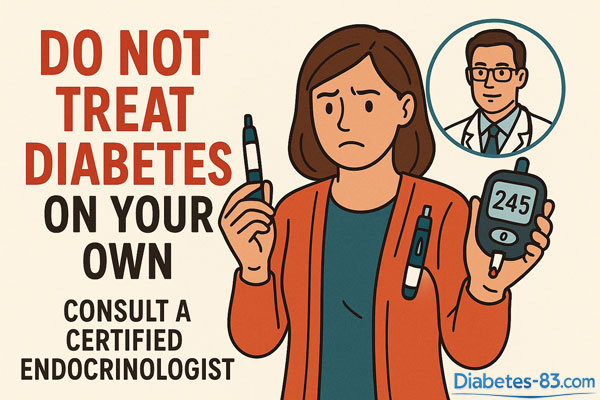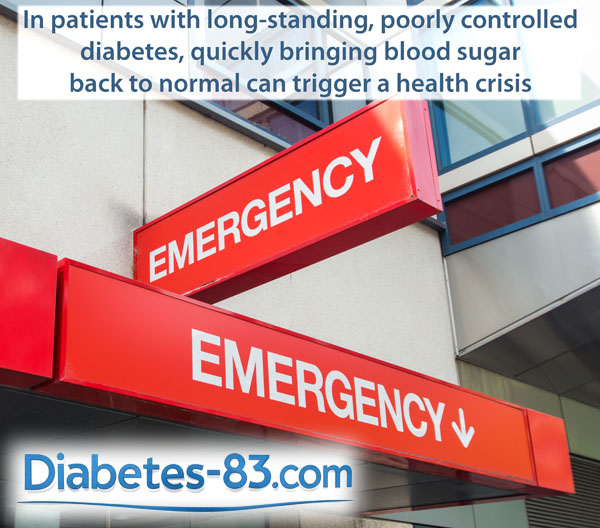Please be advised that the information provided on this diabetes website is intended for general knowledge and informational purposes only. It does not constitute medical advice. This website is not a substitute for professional medical advice, diagnosis, or treatment from a qualified and licensed endocrinologist.

Always seek the advice of your physician or other qualified health provider with any questions regarding your diabetes or other a medical condition. Consult your doctor before making any decisions related to your health or treatment. Never disregard professional medical advice or delay seeking it because of something you have read on this website.
You should consult your physician before making any significant lifestyle modifications, including, but not limited to, changes in your diet, exercise, or medication. Your physician can assess your health status and provide personalized guidance appropriate to your needs.
Legal and Medical Disclaimer
We make no warranties, express or implied, about the completeness, accuracy, reliability, or suitability of the information, products, services, or related graphics contained on this website for any purpose.
Reliance on any information you obtain on this website is solely at your own risk.
Common Problems You May Encounter
Many patients with severe, long-standing diabetes are used to chronically high blood glucose levels. They face difficult situations and are at high risk.

When they try to follow the advice on this site and begin lowering their blood sugar, they often run into the following problems.
- Their health may temporarily worsen. When blood glucose levels return to normal, they can experience symptoms of hypoglycemia, including dizziness, weakness, irritability, and sometimes even fainting.
- For individuals with diabetic retinopathy, rapid improvements in blood sugar control can trigger more frequent and severe eye bleeding. It may increase the risk of vision loss or require urgent eye surgery.
- Many experts claim that a low-carb diet may harm kidney function in people with diabetes and increase the risk of end-stage renal failure—potentially requiring dialysis or kidney transplant. It is a highly controversial topic. You can explore it in more detail here.
Find out more here: potential adverse effects of blood glucose levels normalization.
To avoid the problems or at least alleviate them, follow the steps outlined below.
Key Preventive Measures to Ensure Success
Before you try to apply the advice on this site to improve your diabetes control, make sure to take the following steps.
- Find out the condition of your kidneys by taking the recommended blood and urine tests.
- Plan for the possibility that you might suddenly need emergency eye surgery.
- Obtaining and using a continuous glucose monitoring (CGM) system is highly recommended, although not strictly required.
Blood and urine tests that tell about the health of your kidneys are standard, inexpensive tests that most labs offer. At the same visit to the lab, you can also check your glycated hemoglobin (HbA1c) and key cardiovascular risk markers.
You might suddenly need emergency eye surgery to address a severe hemorrhage and prevent blindness. It’s exceedingly unlikely, but not entirely impossible—so it’s wise to prepare for this scenario in advance. Research reputable specialists who perform such procedures and establish contact with them before a crisis occurs.
A continuous glucose monitoring system is an enormously valuable device for everyone with type 1 or type 2 diabetes—and even for those with insulin resistance but no formal diabetes diagnosis. The insights you gain from real-time glucose data increase your chances of success in normalizing blood sugar. Of course, sensors can be expensive. However, you should prioritize this cost. Investing in CGM sensors now is far more cost-effective than dealing with the financial burden of diabetes complications later.
How to Adjust If Your Body Is Accustomed to High Blood Glucose
Over many years of poorly controlled diabetes, your body may have become accustomed to high blood sugar. In such a case, suddenly lowering your blood glucose to normal levels may trigger hypoglycemic symptoms. To avoid it, you’ll have to lower your blood sugar gradually, in several stages, over 4-8 weeks. This gradual approach will help your body adjust and reduce the risk of experiencing severe hypoglycemia.

To lower your blood glucose gradually, you’ll have to balance carefully your carbohydrate intake with the insulin doses. However, this process can be challenging in practice. Success requires strong motivation, good cognitive skills, and careful attention to detail. A continuous glucose monitoring (CGM) system is essential for tracking your glucose levels in real time, allowing you to make timely adjustments to your insulin and diet.
Let’s review the three key areas you need to address before switching to a low-carb diabetes management system:
- Assess your kidney health.
- Make a plan in case you suddenly need emergency eye surgery.
- Preferably, start using a continuous glucose monitoring system.
By using this website, you acknowledge that you have read, understood, and agree to the disclaimer.